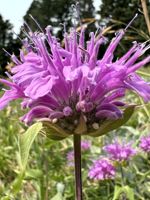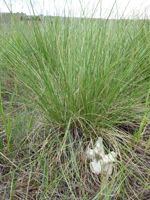Mon-Fri 9am - 5pm Mountain time
Wild Bergamot vs Rough Fescue
Monarda fistulosa
Festuca campestris
NOT AVAILABLE THIS SEASON - MIGHT RETURN
CUSTOM GROW
Wild Bergamot is a native perennial wildflower that is known for its fragrant lilac-purple tubular flowers. The flowers grow in dense terminal heads and bloom from mid-summer to early fall. Deadheading spent flowers will encourage new blooms, prolonging its display. They attract pollinators such as bees, butterflies, and hummingbirds. It also serves as a host plant for the Raspberry Pyrausta (Pyrausta signatalis) butterfly.
Wild Bergamot belongs to the mint family, and its leaves, stems, and flowers are all edible. The leaves can be used to make tea or as a flavorful herb, with a taste often described as a blend of oregano and thyme.
It is resistant to deer and rabbits but can be susceptible to powdery mildew if planted too densely with poor air circulation. Wild Bergamot tolerates heat, drought, and poor soils, making it a low-maintenance addition to a variety of projects. It is well suited for pollinator gardens, wildflower gardens and naturalization projects.
Rough Fescue is a native perennial bunchgrass valued for its tall, dense clumps and long-lived growth. Adapted to cold climates and nutrient-poor soils, it is a defining species of northern prairie and montane grasslands. In western Canada and the northern Rocky Mountains, Rough Fescue is considered a keystone species because it shapes plant communities, stabilizes soils, and supports ecosystem resilience.
It is a cool-season grass, growing most actively in spring and fall and slowing during the heat of summer. Rough Fescue is highly regarded as forage for wildlife and livestock, with elk, deer, and other grazing animals favoring it. Taller than many other fescue species, it is well-suited to prairie restoration, erosion control, and naturalization projects where it supports both biodiversity and long-term ecosystem health.

